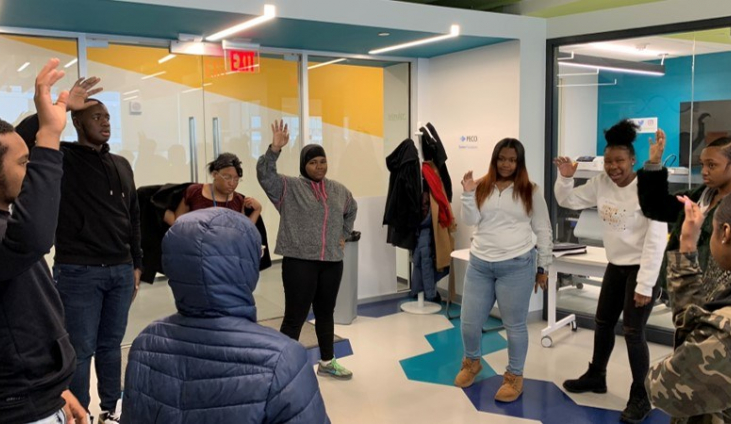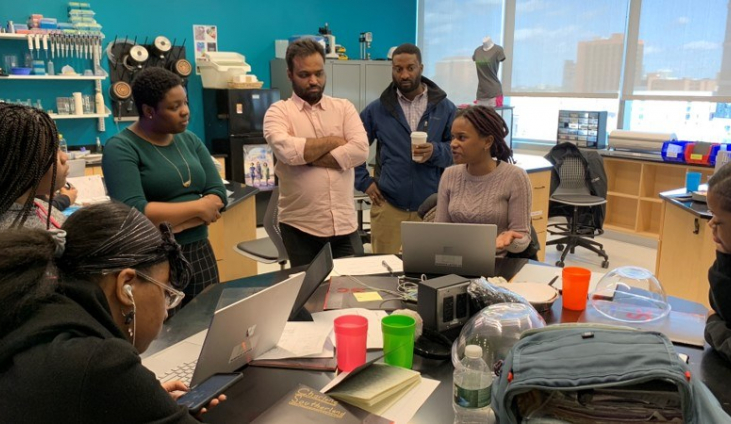Further proving that kids’ natural curiosity towards the world around them is highly compatible with a job market that demands an increasingly specialized and automated workforce, FirstHand the Science Center’s free STEM education program with an emphasis on career exposure, is once again asking us to rethink the age students should begin thinking about career development and exposure, their professional marketability, and the importance of building a network.
“I’m most excited about how I’m gonna actually make something of my own from scratch and look forward to seeing how it turns out. I’ve been working on it every day!”
It’s also continuing to reshape the funding relationship between giver and receiver, going beyond transactional to create mentorship opportunities and an emotional commitment towards a shared mission.
From the beginning of the planning phase between the two organizations, the vehicle for helping high schoolers understand critical infrastructure and learn about different career pathways was defined as an industry challenge that would be true to real life and focused on the placement of wireless nodes to small cell towers (rather than their intricate innerworkings).
What’s a small cell tower? An inconspicuous and non-imposing object that doesn’t look like a tower at all and sustains our wireless coverage. How do engineers determine where and how to best attach a node? The question was first posed to two groups of 10th graders from Robeson High School in West Philadelphia this past January, promoting a mindset of dissecting the context of the problem first in the pursuit of a workable solution.
Over the ten weeks that followed, each team was matched up with the same Crown Castle mentors, who visited the lab regularly for consistency and expectation-setting, in the biggest volunteer initiative for Crown Castle so far.
Building on the strength of FirstHand’s track for high school students, an elaborate simulation of the future “work world” is created for the students, complete with deadlines, clients who expect deliverables and consultation, not to mention a stipend [read: money] upon completing the course. As a result, the students also strengthen their skills in budgeting, teamwork and soft skills.
And while they may not all become Radio Frequency (RF) engineers, they explored a massive industry in a truly vertical fashion, along with all the STEM-adjacent careers and roles moving in concert to pull off a successful installation; fiber office employees, operations, government affairs and legal teams that navigate delays and resistance from municipalities, jurisdictions, and so on.
To determine node placement, the students looked at a map of large and small cell towers across Philadelphia. They pinpointed social media activity and the number of tweets in a block or neighborhood, locating and targeting high traffic intersections where they could install the nodes; all while considering public safety, the preservation of existing infrastructure and accessibility.
The final project asked the students, all of whom are digital natives but may not have previously grasped how relatively new a concept mobile communication is, to design a product prototype that utilizes 5G technology to solve a societal problem. For example: How do we help people with disabilities find greater accessibility? If you could create a “smart city” of the future, what types of amenities or features would it include? Is there a future for smart glasses?
And although recent events caused the final showcase to be postponed, these prototypes will be presented to Crown Castle mentors and staff in the coming months.
10th grader William Beard’s final project consisted of a chip with a 5G boost that when hidden in a treat and ingested by a pet, can notify the owner of an infection or illness through a mobile app that connects to a phone’s Bluetooth. After meeting with his mentor, he was advised to notify veterinarians and doctors at Penn and connect them with his team’s app. “[it’s] getting me ready for the world, what it’s going to be like,” he explained when asked how this experience has opened his eyes to the world of telecommunications. “I’m feeling really good about that,” he adds.
Tiara Milas-Stark appreciates the process. "I’m most excited about how I’m gonna actually make something of my own from scratch and look forward to seeing how it turns out. I’ve been working on it every day!" When asked how her meeting with her mentor went, she happily reported that she has pivoted from her mobile app maze game to an escape room with multiple levels.
Her friend Jada Rutling is working on a drone to help remote villages in Africa find clean water so they can spend less time traveling and more time with their communities and families. Her mentor has helped her incorporate GPS and determine how far users can expect to get a signal. The experience in general taught her just how much goes into placing a node; from the signal, to the cost, to the expenditure of time.
Technology as ubiquitous and as pervasive as the internet is easily taken for granted. One need only look at current social distancing measures in response to this global pandemic to realize how much wireless connection has shaped the way we work, study and socialize. We’ve come to expect it to work as efficiently as the flick of a light switch, but these students now notice small cells everywhere.
In the long term, we're envisioning what's possible for these students’ careers.
In the shorter term, we’re envisioning a conversation where the roles reverse, and kids get to tell us how things work.
And we may all be okay with that.









